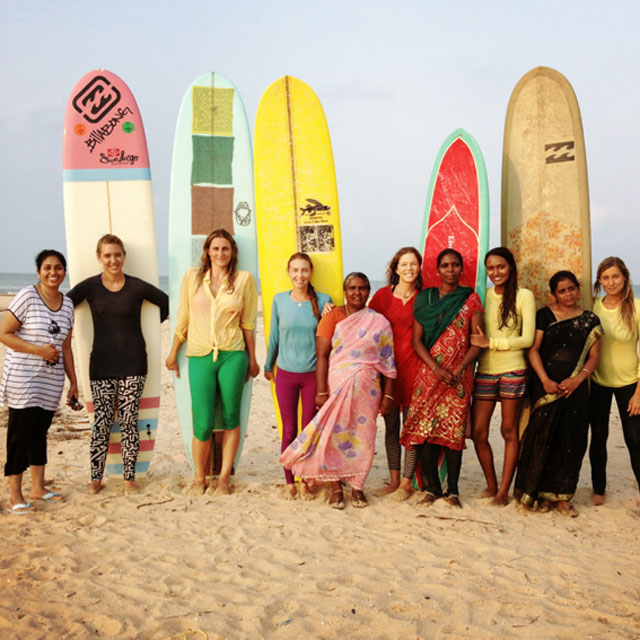The crew of Beyond the Surface film, plus the first Indian women to surf in saris. While filming we worked with Beyond the Surface International, using surfing as a tool for sustainable community building and youth empowerment. Photo: Knutson
*This article was originally published in SurfGirl Magazine.*
Travel is a mirror that reflects us back to ourselves—the stripping away of cultural comforts, routine and familiarities creates opportunities for revealing both the unexpected and the unexpectedly familiar. More often than not, it’s a process of remembering what we know.
India is a country steeped in contradiction; it is confronting and perturbing, but also deeply moving. More than one billion people occupy the subcontinent; a seventh of Earth’s human population.
Indian surfers are mostly patient and exceedingly full of stoke. All 100 or so of them wait with baited breath for swells to finally filter in, as surfers do in countries where surfing is either new or swell is a measurably finite resource. In India, both are true—not yet crowded, not yet jaded.
~
I traveled with five other lady sliders to a remote coastal corner of Tamil Nadu in search of a proper point break. The crew included professional waterwoman Liz Clark, artist Chrystal Thornburg-Homcy, humanitarian Emi Clark, yogini Kate Baldwin and India’s first recognised female surfer, Ishita Malaviya. We were all especially stoked to be traveling with Ishita—a woman who’s inspired us all with her unrelenting ambition to follow her dreams of becoming a surfer, despite oppressive cultural norms that have kept so many women from pursuing their passions.

Ishita pre-surf while on location with Beyond the Surface film in South India. Photo: Lauren Hill
We found the pointbreak, but swell never quite did it justice. After eight hours of driving, we watched as three feet of swell smashed the outcropping of rocks off of the headland, and then continued its way northward. The swell was too south to significantly filter into the manicured sandy point.
Unoccupied by swell, we visited a local women’s self-help center, where girls and women are taught to hand dye and weave native palm leaves into beautiful and intricate handicrafts. In turn, the women of surrounding villages may earn financial independence from their craft and support their families when husbands go awry or fall to the hand of alcoholism, as is so common there.
India is ranked as the fourth most dangerous country in the world for women, just behind Afghanistan, Congo, and Pakistan. A common Indian proverb states, “raising girls is like watering someone else’s lawn,” speaking to the generally accepted senselessness of having girls at all. Most girls in India (if they are not aborted because of their sex) face a lifelong battle against “normalized sexism,” or being considered less valuable, capable, and worthy than their brothers. Most women are denied access to education or work and play outside of the home.
In the women’s self-help center, one of us finally mustered the courage to ask the women weavers if they’d like to try surfing. With shy glances and girlish giggles, they agreed, and we had the humbling experience of taking two local women surfing. With no culturally appropriate alternatives for swim or sport wear, they wore their saris into the Bay of Bengal; nine yards of brightly dyed fabric, expertly wrapped, folded and draped around their bodies. The saris proved completely (and elegantly) covering on land, but wholly weighty in the water. I watched the women pull and tug on the fabric as the water gripped it, slowing them down, unraveling; a symbol for the cultural weights women must bear, just for being women. Restricted from overly flamboyant (or just buoyant), dynamic movement by sexist norms that insist women are more suited for passivity than engagement; for watching, not doing. We pushed them into waves on their bellies and they taught us Bollywood dance moves while knee deep in sea. They were probably the first women ever to ride waves in saris.

A spontaneous Sari-soaked cool off in the shallows of the Indian Ocean to escape the swelter of the Kearalan heat. Photo: Lauren Hill
One of the things that traveling to India helped me to remember, especially surfing with those sari-clad women, is what a privilege surfing is. We are crazy fortunate to feel salty sea air upon our bare skin. Not only to be able to physically “feel,” but to be free of social and political barriers that might tell us that being bare in the sea is wrong. Sinful, even. An Indian woman might be called promiscuous for playing amongst the elements in the presence of men. We have the immense gift of leaving all of the weight of the terrestrial world behind for the sole purpose of play. It revitalises and inspires. And then the ocean treats us all the same.
We are of the freest and most capable women ever to live on planet Earth. This is not something to be taken for granted. It is a charge and a responsibility to reach out, especially to our sisters all over the world, who long to be free, who dream of finding their passions and losing themselves in the freedom of it, just like us, but maybe more beautifully than we could ever imagine.
~
~
Relephant:
Surfing in India: The Difference between Spirituality & Religion.
~
Author: Lauren L. Hill
Editor: Katarina Tavčar








Read 1 comment and reply